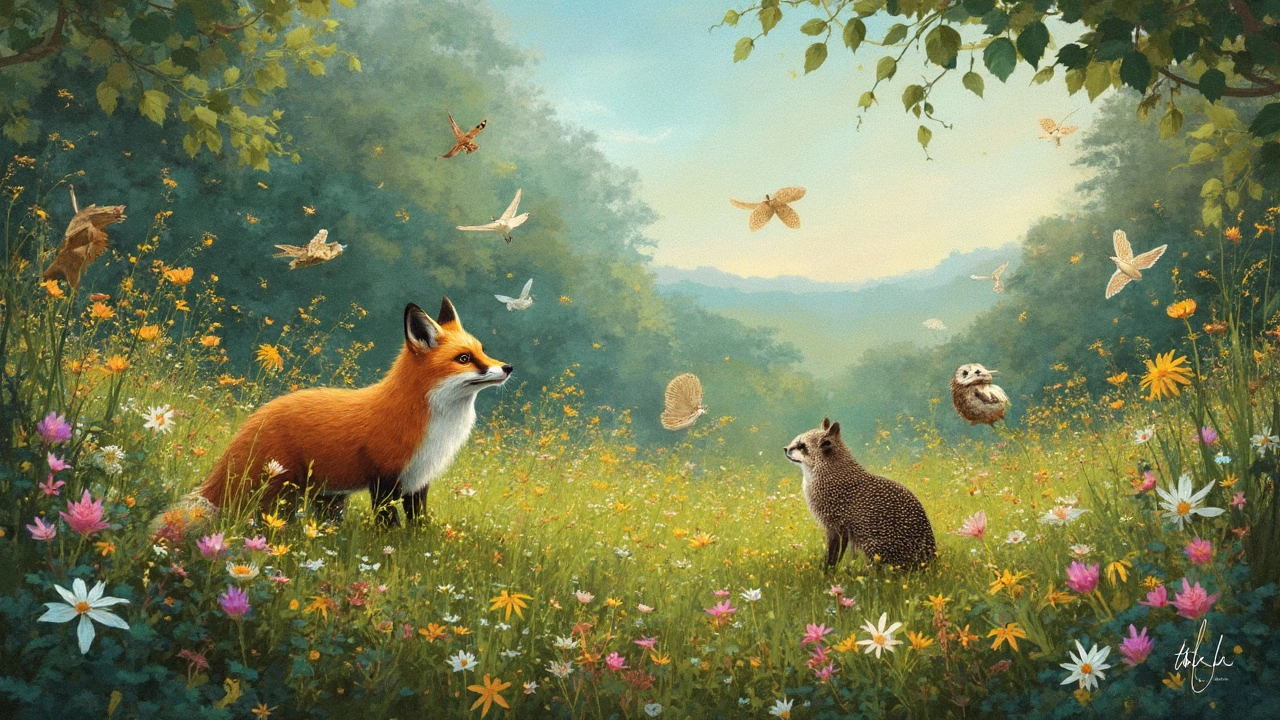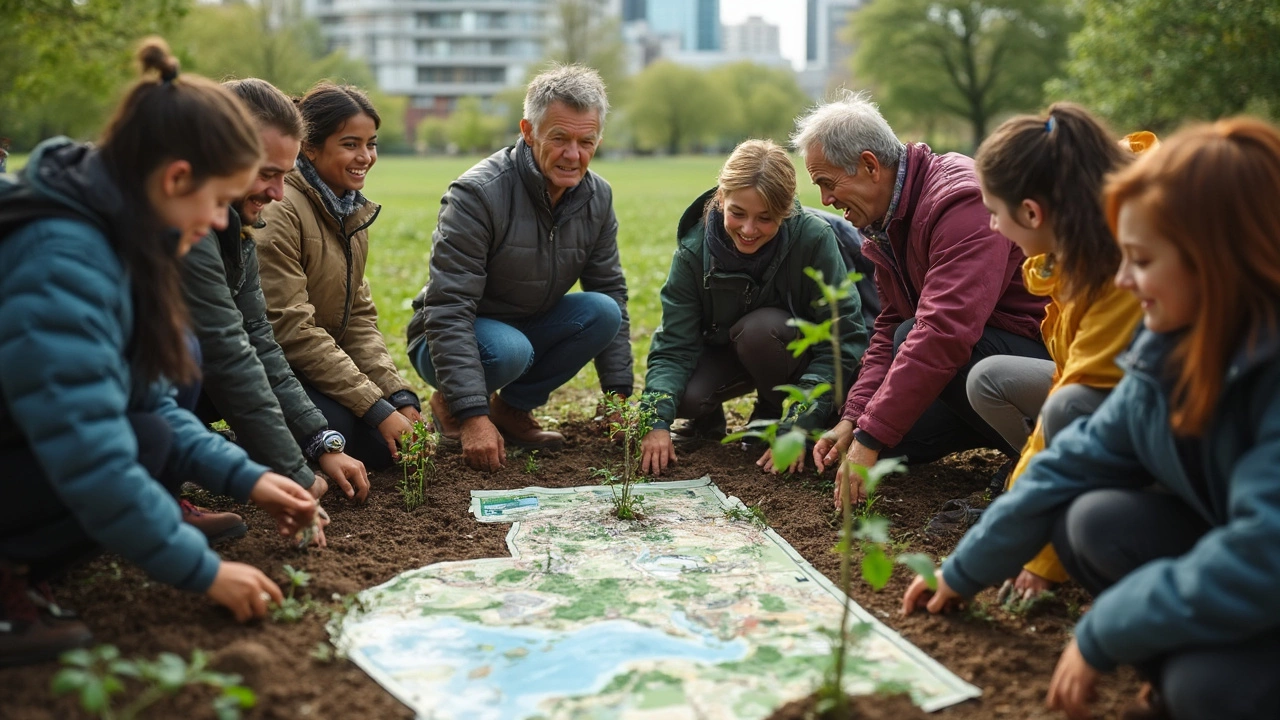Ecological Community: What Is It Called and Why Does It Matter?
 Jun, 4 2025
Jun, 4 2025
So, what exactly is an ecological community? In science talk, it’s a group of different species living together in the same spot, all depending on each other in one way or another. Picture a pond, where frogs, ducks, bugs, and plants all rub shoulders—well, that’s an ecological community, right there in action.
But who cares, really? Turns out, these communities aren’t just science textbook fluff. They’re the very heart of healthy ecosystems. Take away one piece—a certain bug, bird, or plant—and you risk throwing the whole balance off. If you’ve ever seen a lake overrun by algae because the fish disappeared, you’ve witnessed what happens when a community falls out of balance.
- Defining an Ecological Community
- Life Inside Natural Communities
- Ties to Environmental Groups
- Simple Ways to Get Involved
Defining an Ecological Community
An ecological community is just all the different plants, animals, fungi, and even microbes living together in the same area. What counts as “the same area” can change—a tidepool, a forest patch, or your local park can each hold their own unique community. The key point is it’s not just one species, but a bunch, all living and interacting in ways that keep things ticking.
Scientists usually think of an ecological community as everyone sharing resources, like water, sunlight, or food, and dealing with their neighbors—sometimes cooperating, sometimes competing. If you’ve ever seen birds chasing each other off a feeder or flowers out-competing each other for sunlight, that’s classic community stuff.
Communities come with all kinds of variety, from simple—maybe just a few types of grass and insects—to really complex, like a rainforest with thousands of species working together. Scientists like to get nerdy and measure that variety, calling it “species richness.” In one square meter of tropical rainforest, you can find more than 200 different types of plants, while in tundra, you might see only a handful.
| Community Type | Average Number of Species |
|---|---|
| Temperate Forest | 60-90 |
| Tropical Rainforest | 200+ |
| Coral Reef (per 100 m2) | 500 |
| Desert | 15-30 |
Why does knowing this matter? Every species adds something, even if it’s small. More variety in a community usually means it bounces back from trouble (like droughts or disease) more easily. That’s why keeping communities healthy is such a big deal for anyone who cares about nature or wants to keep the environment in good shape.
Life Inside Natural Communities
When you think about nature, everything is pretty connected. In an ecological community, all sorts of plants, animals, and even fungi interact in ways that help things run smoothly—or not, if something is off. For example, bees pollinate flowers, frogs eat bugs, and fallen leaves become food for tiny soil critters. No one’s just hanging out alone. Each member has a “job” that keeps the place ticking.
Sometimes these relationships are friendly, like birds eating berries and spreading their seeds. Other times it’s more about competition, like when different trees fight for the same sunlight. Even things you can’t see, like bacteria, are busy recycling dead stuff into nutrients plants can use.
Here's a look at a few real numbers to show how packed even a small area can be:
| Community Type | Average Species Count (per hectare) |
|---|---|
| Tropical Rainforest | 400 tree species |
| Freshwater Pond | 100+ animal species |
| Prairie Grassland | 60+ plant species |
If one piece is missing, things can go sideways fast. A famous case—when wolves vanished from Yellowstone, elk numbers exploded and ate too many young trees, shrinking habitats for other wildlife. Once the wolves returned, balance came back. Each role, big or small, really matters.
If you're curious about local communities in your area, grab a notepad and write down every plant or animal you spot next time you’re in a park. It’s a good way to see just how many living things rely on each other—right in your backyard.

Ties to Environmental Groups
Ever notice how nature and people-powered groups are a lot alike? Ecological communities in the wild are all about working together, and so are environmental groups. These groups, whether global giants like the World Wildlife Fund (WWF) or local beach clean-up crews, are built on teamwork and diversity—just like a forest or coral reef. Each member brings something unique, whether it’s expertise, fresh energy, or local know-how.
Environmental groups often focus on protecting or restoring actual ecological communities. The Sierra Club, for example, fights to save natural habitats across North America. They’re famous for standing up against big projects that threaten balanced communities of plants and animals. Friends of the Earth UK works with towns to create pollinator-friendly zones, helping bees and butterflies do their thing. It’s less about heroic individuals and more about collective action, kind of like how wolves, birds, and trees all shape a forest together.
Curious about how environmental groups actually make a difference? Check out these real numbers from 2024:
| Group | Focus | Active Projects | Habitats Protected (sq km) |
|---|---|---|---|
| WWF | Wildlife Conservation | 1,200+ | 1,300,000+ |
| Sierra Club | Habitat Protection | 400+ | 200,000+ |
| Friends of the Earth | Urban Green Spaces | 150+ | 10,000+ |
These projects aren’t just big numbers—they’re actual grasslands, forests, and streams given a fighting chance. By acting together, these groups kind of imitate the resilience and balance you see in a natural ecological community.
Want to join in? Many groups let you volunteer, donate, or even contribute ideas for new initiatives. Whether you’re picking up trash with a local river crew or signing petitions online, you become a part of something that’s bigger and tougher than any one person—just like those interconnected species in the wild.
Simple Ways to Get Involved
If reading about ecological communities makes you want to actually help out, you’re in luck—there are loads of easy things you can do that make a real difference. You don’t have to be a scientist or full-blown activist either. Regular people power a lot of positive change right now.
To start, joining local ecological community cleanups is one of the most practical actions. Many groups organize monthly events to clean parks, rivers, or beaches. Plus, according to a 2024 EPA report, volunteer cleanups have removed over 75,000 tons of trash from U.S. waterways in the past decade alone.
- Plant native species: Native plants support local pollinators and wildlife way better than non-native grass lawns. Try swapping some garden spots for milkweed or coneflowers.
- Reduce single-use plastic: Even refusing one plastic bag or bottle keeps garbage out of the food chain. Cities like San Francisco cut plastic bag waste by up to 70% after switching to reusable alternatives.
- Support environmental groups: Look into groups like The Sierra Club, local watershed alliances, or community gardens. They’re always looking for more hands, donations, or even just folks willing to spread the word.
- Become a citizen scientist: Projects like eBird, iNaturalist, or local frog counts need everyday people to report sightings. This helps scientists keep tabs on the health of ecosystems.
Want some quick stats about how people pitch in? Check out this snapshot below:
| Action | Impact |
|---|---|
| Urban Tree Planting | Shades, cools, and cleans city air—neighborhoods with lots of trees can be up to 6°F cooler in summer |
| Beach Cleanups | For every hour, about 7 pounds of trash is collected per volunteer, according to Ocean Conservancy (2023) |
| Native Gardens | Can boost local butterfly and bee numbers by 3x in one season |
Really, there’s no perfect time to start. Every tiny action chips in to protect the whole community, whether it’s picking up a piece of trash, switching to a cloth shopping bag, or giving an hour to a local group. If you’re not sure where to start, just reach out to environmental groups nearby—they’re usually thrilled to welcome new people.
